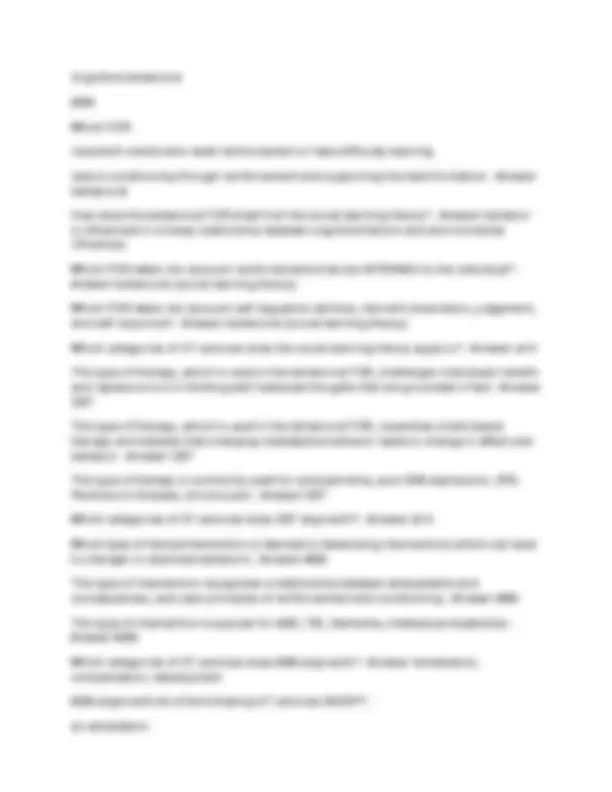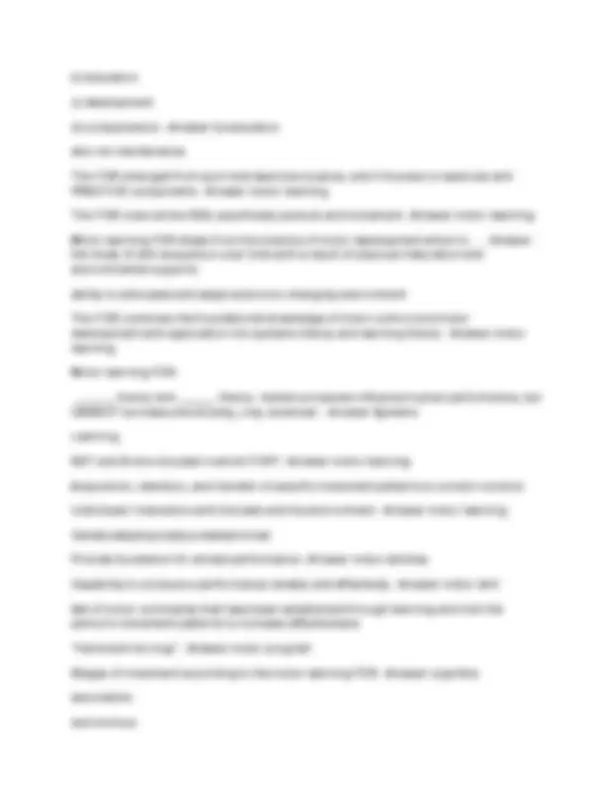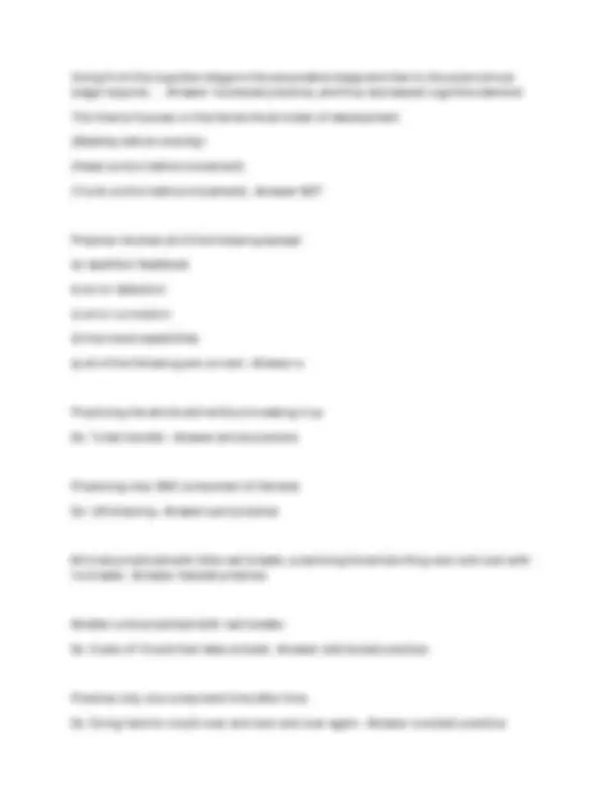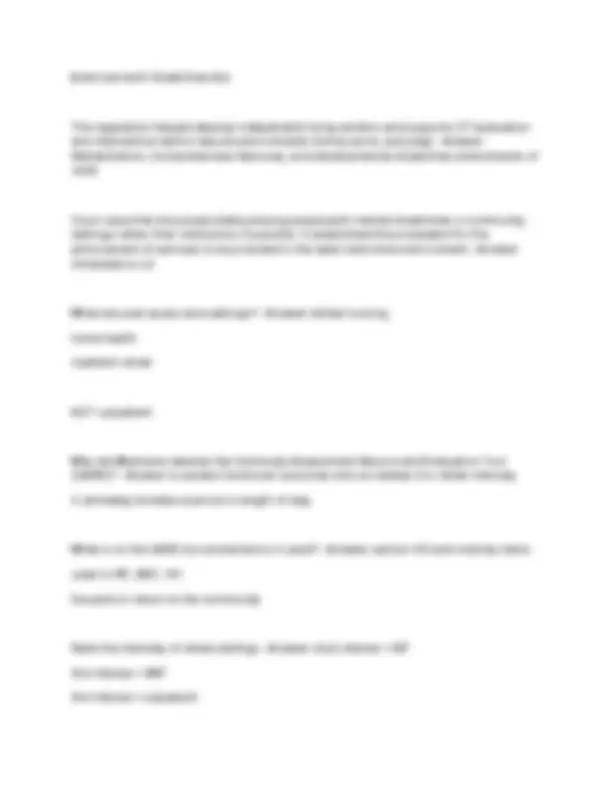







Study with the several resources on Docsity

Earn points by helping other students or get them with a premium plan


Prepare for your exams
Study with the several resources on Docsity

Earn points to download
Earn points by helping other students or get them with a premium plan
Community
Ask the community for help and clear up your study doubts
Discover the best universities in your country according to Docsity users
Free resources
Download our free guides on studying techniques, anxiety management strategies, and thesis advice from Docsity tutors
OTH 330- Weeks 9-13 Test With Complete Solution
Typology: Exams
1 / 9

This page cannot be seen from the preview
Don't miss anything!






When do we decide what intervention to use for a client? - Answer during the hypothesis also begins during the evaluation Deciding an intervention is a ______ process - Answer fluid, not rigid Reflection during action - Answer making sure what you are doing is working reflection before action - Answer thinking through a situation before (planning, what will happen) Reflection after action - Answer did your treatment work, was it effective Define "intervention process" - Answer An action process by the OT to improve a situation or address a client concern as part of the OT process 3 components of the intervention process - Answer plan implement review This is where you determine your intervention based on the patient's length of stay, protocols, and number of visits. - Answer intervention process During the intervention process, the therapist creates goals in collaboration with the ....
Is it occupation based? Need for further services/referral? Time for d/c? There is a relationship between the evaluation and intervention plan How? - Answer what you use as part of your interventions ties back to what you learn from the evaluation process ex: you would work on postural control/stability if your patient fell over EOB during the initial evaluation Occupation based interventions - Answer Purpose: Client engages in client-directed occupations that match identified goals. Examples:
- Completes morning dressing and hygiene using adaptive devices • Purchases groceries and prepares a meal • Utilizes the transportation system • Applies for a job •.Plays on playground and community recreation equipment • Participates in a community festival • Establishes a pattern of self-care and relaxation activities in preparation for sleep Where do we pull goals from? - Answer the client How do you provide occupation-based interventions? - Answer break the occupation down into specific tasks/movements Set of assumptions/concepts that are drawn from theory which guide the OT process Embedded deep into the domains of OT - Answer frames of reference T/F: Frames of references are built upon science and clinical knowledge BOTH within OT AND outside of OT - Answer true Plausible of scientifically acceptable principle(s) which explain a phenomena Used to describe, explain, and predict behavior/relationships among events - Answer theory FOR: Established upon behavioral science that looks at human actions within society - Answer behavioral FOR: Research is grounded in neural function and observable behavior - Answer behavioral Theories included in the behavioral FOR - Answer Classical conditioning Operant conditioning Social learning
b) education c) development d) compensation - Answer b) education also not maintenance This FOR emerged from sport and exercise science, and it focuses on exercise and PRACTICE components - Answer motor learning This FOR looks at the CNS, specifically posture and movement - Answer motor learning Motor learning FOR draws from the science of motor development which is ... - Answer the study of skill acquisition over time with a result of physical maturation and environmental supports ability to anticipate and adapt actions to changing environment This FOR combines the foundational knowledge of motor control and motor development with application into systems theory and learning theory - Answer motor learning Motor learning FOR: _______ theory and _______ theory- mental processes influence human performance, but CANNOT be measured directly, only observed. - Answer Systems Learning NDT and SI are included in which FOR? - Answer motor learning Acquisition, retention, and transfer of specific movement patterns to a motor solution Individuals' interaction with the task and the environment - Answer motor learning Genetically/physically predetermined Provide foundation for skilled performance - Answer motor abilities Capability to produce a performance reliably and effectively - Answer motor skill Set of motor commands that have been established through learning and limit the person's movement patterns to increase effectiveness "Hand and hot mug" - Answer motor program Stages of movement according to the motor learning FOR - Answer cognitive associative autonomous
Going from the cognitive stage to the associative stage and then to the autonomous stage requires... - Answer increased practice, and thus decreased cognitive demand This theory focuses on the hierarchical model of development (Stability before mobility) (Head control before movement) (Trunk control before movement) - Answer NDT
Practice involves all of the following except: a) repetition feedback b) error detection c) error correction d) improved capabilities e) all of the following are correct - Answer e
Practicing the whole skill without breaking it up Ex: Toilet transfer - Answer whole practice
Practicing only ONE component of the task Ex: UB dressing - Answer part practice
All trials practiced with little rest breaks; practicing the whole thing over and over with no breaks - Answer massed practice
Smaller units practiced with rest breaks Ex: 3 sets of 15 and then take a break - Answer distributed practice
Practice only one component time after time Ex: Doing hand to mouth over and over and over again - Answer constant practice
Consulting with retired individual on volunteer opportunities related to their job is an example of an intervention modification to the _____ context - Answer temporal
Collaborating with teachers on appropriate technology for a student is an example of an intervention modification within the _______ context - Answer virtual
Civil rights law that sates no person may on the basis of his or her disability, be excluded from the participation in, or denied the benefits of any program or activity receiving federal financial assistance. - Answer section 504 of the rehabilitation act
What legislation helps to suggest and implement needed modifications and accommodations in school system to ensure that students with a qualifying disability gets the services they need? - Answer section 504 of rehabilitation act
What legislation serves of accountability standards for schools receiving federal funding? - Answer no child left behind
Part C of IDEA - Answer early intervention
Part B of IDEA - Answer age 3-21 free public education
The ______ established OT as a primary service provider for birth to 3 - Answer Individuals with Disabilities Education Improvement Act
This legislation created a network of local and state programs called Area Agencies on Aging; provides flexible funding options that support community health and social services for older adults, which includes OT. - Answer older americans act 1985
This legislation was built on civil rights legislation with the goal to protect rights and enhance participation. It supports OT initiatives and interventions focused on function and participation across the lifespan. - Answer ADA
American with Disabilities Act
This legislation helped develop independent living centers and supports OT evaluation and intervention within natural environments (home, work, and play) - Answer Rehabilitation, Comprehensive Services, and developmental disabilities amendments of 1878
Court case that discussed states placing people with mental disabilities in community settings rather than institutions if possible. It established the precedent for the enforcement of services to be provided in the least restrictive environment - Answer Olmstead vs LC
What are post acute care settings? - Answer skilled nursing home health inpatient rehab
NOT outpatient
Why did Medicare develop the Continuity Assessment Record and Evaluation Tool (CARE)? - Answer to assess functional outcomes and correlates it to rehab intensity it ultimately dictates a person's length of stay
What is on the CARE tool and where is it used? - Answer section GG and mobility items used in IRF, SNF, HH focused on return to the community
Rank the intensity of rehab settings - Answer most intense = IRF 2nd intense = SNF 3rd intense = outpatient